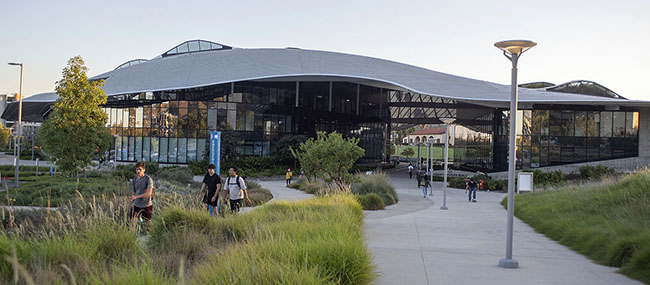Questions raised over sale of surplus properties
There was a moment of tension at Thursday’s meeting of the Claremont Unified School District Board of Education when the board was called upon to approve a report by the Surplus Advisory Committee, also known as the 7-11 Committee.
In December of 2010, the school board approved the formation of the committee, which is comprised of a group of real estate-savvy volunteers, to discuss the potential sale, lease or use of surplus district property.
After 2 recent public hearings, the committee has recommended that 2 parcels of land, the Base Line Road property where the district’s service center is currently located and the site of the short-lived La Puerta junior high school on Forbes Avenue, be declared surplus and sold.
Approving the 7-11 Committee’s report does not mean that the board is agreeing with its determination or that the board is moving forward with the disposal of the property, Lisa Shoemaker, CUSD vice president of business services, noted. Instead, she said, it simply acknowledges that the committee has completed its task. Nevertheless, Board Vice President Steven Llanusa hesitated before adding his stamp to the rest of the board’s approval of the report, citing concern about preparing to sell the property where the service center is located before relocating it. The district, he pointed out, does not yet know how much it will cost to relocate the center.
Committee member Brad Umansky, who was on hand to answer questions about the process undertaken by the 7-11 Committee, said he understood Mr. Llanusa’s concern. If the cost to relocate the service center were to be $2 million and the property were to sell for only $2 million, it would certainly not be a worthwhile transaction.
He cautioned, however, against waiting too long to declare the property surplus at the risk of a timely sale that might net the district a good deal of money. Home developer D.R. Horton has already purchased an adjoining property on Base Line Road from CUSD, he noted. There is a good chance that the same developer might want to bid on the second property, drawn by the potential economy of scale. There is a finite window, however, in which the company might reasonably be amenable to such a purchase.
The job of the board, Board Member Jeff Stark emphasized, is to use district resources in a way that will yield the most profit for Claremont schools.
“We have to be good stewards of our assets,” he said.
Mr. Llanusa warned against haste and expressed concerns that the service center might find itself without a home for a time or that a new service center might have to encroach on a valuable CUSD asset, such as a lighted soccer field.
Mr. Umansky said that it would be at least a matter of months after the sale of the property goes through before CUSD would have to vacate the property, given the lengthy escrow period. The other property recently acquired by D.R. Horton is still in escrow. It might be possible, however, for the district to negotiate with a buyer for a longer period of occupancy, he said.
While Ms. Shoemaker said that a developer like D.R. Horton is likely able to pay a higher price than any other entity, she described the state-mandated process for the sale of school property.
Public agencies throughout the state, such as municipalities or water districts, must be given the first shot at bidding on the property. If no agency has a bid that conforms to the district’s asking price or terms within 60 days, the property then goes to public auction, where it will be sold to the highest bidder.
Board member Sam Mowbray said that the potential sale of these properties has been going on for well over a decade. He acknowledged that finding an alternative site for the service center is a top priority for the district, but warned against a costly hesitance.
“I caution you against going down a path that has a long, tedious process,” he said.
Mr. Llanusa reminded the school board that the board had seriously pondered moving the service center to the city yard some 7 years ago, a proposal he said turned out to be infeasable.
Mr. Llanusa emphasized that the well-being of CUSD students is more important than the aforementioned window of time.
Having voiced his concerns, Mr. Llanusa joined with the rest of the board in approving the 7-11 Committee’s report, accepting but not agreeing with or acting upon its recommendations.
Board approves continued CLASP research
There was an element of show-and-tell at Thursday’s meeting when the board honored the Claremont AfterSchool Program (CLASP) for winning the Golden Bell Award.
The award, presented by the California School Boards Association to programs that demonstrate exemplary support of learning and teaching that is ongoing and sustainable, comes in the form of an actual oversized metal bell. When CLASP president Teddie Warner and her staff were beckoned to the dais in acknowledgement of the accolade, Superintendent Jim Elsasser and a few board members took a moment to give it a resounding ring.
“I’m not sure who coined the phrase ‘stability in motion,’ but it perfectly describes what you do,” said Mr. Llanusa. “You provide stability for our children and you’re always in motion, finding new ways and people to do it.”
CLASP offers academic and emotional support to some 150 children at risk of falling through the cracks in the educational system. Three days a week, the kids, who are in second through sixth grade, head to the program for an hour of help with their schoolwork, a hour of recreation and a healthy snack.
If the Golden Bell Award acknowledged the uniqueness of the program, which is volunteer-driven, Jack Mills, PhD of Choice Point Applied Research is seeking to demonstrate its statistical effectiveness. Last year, the board approved a research proposal from Mr. Mills, allowing him to collect student data in order to analyze the impact of participation in CLASP on academic achievement and other student outcomes such as attendance.
Mr. Mills shared some promising data in the form of a 3 percent gain in English Language Arts proficiency among CLASP participants, and asked that he be allowed to continue the study another year.
This year, he hopes to evaluate students’ physical fitness as well as their academic achievement. Mr. Mills said he also hopes to remedy some weaknesses in his research methodology. For instance, last year, CLASP students were compared with students from similar ethnic and economic backgrounds. However, among the CLASP students, the study did not account for how many hours the students had participated in the program. One student, Mr. Mills noted, might have only attended 3 hours of instruction, while another may have participated in 100 hours of the program.
With his request approved, Mr. Mills hopes that next year, with a second round of research under his belt, he will be able to present findings that are more accurate, more thorough and which—given 2 years of study—are longitudinal.
A couple board members expressed regret that the study only used state testing to measure the progress of CLASP students as opposed to other factors like improved grades. Given the greater subjectivity of report cards, however, Mr. Mills said STAR scores represent the most uniform benchmark. The board thanked and congratulated Mr. Mills on his progress towards an ambitious and worthy goal.
Board thanks other contributors
The board also gave thanks to outgoing student board members, Maggie Elizalde of San Antonio High School and Maranatha Croomes of Claremont High, who have dedicated 2 evenings a month throughout the past semester to reporting on the activities of students at various Claremont schools. When each student was acknowledged by president Mary Caenepeel, she proved more adept at reading their names than former board president Mr. Stark.
“Tonight must be very special for you both, because it’s the first time your names have been pronounced correctly,” Mr. Stark joked.
The board also had praise for Sue Brannon, CUSD Purchasing Coordinor, whose leadership with regards to the district’s first-time participation in the American Express Purchasing Card Program, which netted the district an $11,224 rebate. The money was presented in person to the board by Christian Mendoza, manager of business development for American Express, in the form of an oversized check.
“Tonight, we have before you a feel-good item, which you don’t always get from me,” Ms. Lisa Shoemaker said.
Next year, it is likely that the rebate will be even greater, as staff throughout the district become more acquainted with how to best leverage the program, Ms. Shoemaker noted. “I think Sue is a great illustration of how every little effort counts,” she added.
—Sarah Torribio
storribio@claremont-courier.com










0 Comments